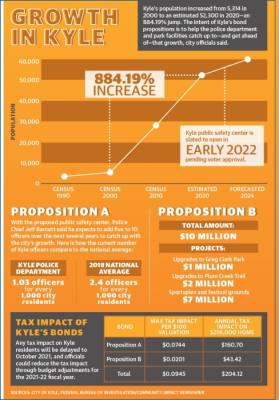Early voting for the Nov. 3 general election beginsOct. 13, which means area residents will be able to vote on a $75 million Hays County bond, and combined with that, Kyle residents will consider an additional $47 million for two bonds.
The Hays County bond, if passed, will create new parks, trails and conservation areas across the county.
The two bond propositions in Kyle will provide $37 million for the construction of a new public safety center for the city’s police department as well as $10 million for a regional sportsplex and festival grounds.
A fourth bond proposal for $217.3 million was canceled in August by the Hays CISD school board due to concerns about how the coronavirus pandemic would affect district finances. However, that bond could resurface for a vote in 2021.
Despite the pandemic and economic uncertainty, officials from Hays County and the city of Kyle were confident the timing was right for their bond propositions.
“We’re now to a point where the decision needs to be made whether or not we’re going to invest in the community,” Kyle Mayor Travis Mitchell said.
County's park bond would not have any tax impact
The Hays County bond, if passed, will create new parks, trails and conservation areas across the county.
The two bond propositions in Kyle will provide $37 million for the construction of a new public safety center for the city’s police department as well as $10 million for a regional sportsplex and festival grounds.
A fourth bond proposal for $217.3 million was canceled in August by the Hays CISD school board due to concerns about how the coronavirus pandemic would affect district finances. However, that bond could resurface for a vote in 2021.
Despite the pandemic and economic uncertainty, officials from Hays County and the city of Kyle were confident the timing was right for their bond propositions.
“We’re now to a point where the decision needs to be made whether or not we’re going to invest in the community,” Kyle Mayor Travis Mitchell said.
County's park bond would not have any tax impact
The $75 million Hays County Parks and Open Space Advisory Commission, or POSAC, bond would provide partial or full funding for 16 projects if approved.
Mark Kennedy, Hays County general counsel, said the bond would not impact the county’s property tax rate, and the remaining balance needed to complete planned projects—estimated at $19,969,525—would be provided through the county budget, other organizations, participating municipalities and other funding sources.
Some of the proposed projects would provide reserves for endangered species such as the golden-cheeked warbler and are eligible for federal or state credits, while others provide flood mitigation benefits, Kennedy said.Mark Kennedy, Hays County general counsel, said the bond would not impact the county’s property tax rate, and the remaining balance needed to complete planned projects—estimated at $19,969,525—would be provided through the county budget, other organizations, participating municipalities and other funding sources.
“We don’t need to go very far back to see that the 2015 floods ... were horrific, and we had loss of life and a tremendous loss of property values—damaged properties,” Kennedy said. “We haven’t really finished recovering from that and won’t completely. Our recovery effort at the county level didn’t finish until around 2018.”
Estimates show the damage caused by the 2015 floods amounted to almost $500,000 in Kyle and led to more than $33 million in federal relief grants for the city of San Marcos, according to previous reporting from Community Impact Newspaper.
Alexandra Thompson, Hays County natural resources coordinator, said land management benefits brought through the proposed bond extend far beyond flood mitigation.
“If you protect this land, not only are you protecting water quality, groundwater and surface water—and protecting habitat and allowing the public to have a space to go for various types of recreation—but then you’re also preventing and mitigating future floods,” Thompson said. “There’s really no bad angle by doing these projects."
Beyond the environmental benefits, proposed projects such as the 535-acre Sentinel Peak Park and Preserve include hiking trails and river access and recreation areas. Previously owned by the Boy Scouts of America, some trails already exist on the property, which would reduce the amount of time it would take to open the park to the public once the land is purchased.
“I think that we could be open with some of the projects in as little as one and a half to two years. Others will take longer,” Kennedy said. “Coleman’s Canyon is a good example. It won’t take a lot of capital investment to establish some primitive trails on that open space, and so we could probably open aspects of it right away.”
Other projects could take considerably longer, and Kennedy noted that some projects included in the county’s 2007 parks bond took up to 10 years to complete.
The 2007 bond leveraged $30 million to create 20 projects through matching funds from other entities, and Hays County invested roughly $30 million in additional funds, according to county documents. Projects from that bond include Five Mile Dam Park, Jacob’s Well Natural Area and Hays County’s Youth Sports Complex.
Much of the POSAC bond was planned around the future growth of Hays County. According to the San Marcos Platinum Planning Study, the county’s population is expected to grow 268% by 2045—from 172,000 to 633,000 residents.
“We need to be able to provide amenities for current and future residents so there’s enough nature enjoyment to be available to everybody that lives here,” Thompson said. “Then [there is] also the ecosystem services that will be provided by protecting the natural resources like groundwater recharge and water quality of the groundwater as well as the springs and surface water ecosystem services.”
Kennedy said that while the bond election would authorize the county to issue the $75 million bond, it would not do so right away.
“The strategy is to see if there’s interest from the voters,” Kennedy said. “If they say no, then we go about doing our business. If they say yes, then we monitor property values in the coming year and then choose if and how much of the authorization we have to use at that time.”One thing the pandemic has taught officials, he said, is the value of natural spaces available to the public.
“People are thinking about outdoor spaces right now more than they ever have because it’s been the one place you can go and recreate,” Kennedy said.
Proposed Kyle bonds defer tax impact until 2021
Beginning Oct. 13, Kyle voters will decide on a $37 million bond for a new public safety center and a $10 million bond for a proposed sportsplex and festival grounds.
Mitchell said plans for the center—Proposition A—are ready for execution, and construction could begin as soon as spring 2021. The facility could be move-in ready in early 2022, he said.
The center would consolidate the city’s police department in a central location and alleviate numerous issues facing the city’s law-enforcement officers, Police Chief Jeff Barnett said. He added the department’s current arrangement has them spread across multiple aging facilities.
Current department locations include a building that previously served as a bank, and another was a post office. Barnett said the Kyle Police Department also has roughly seven other buildings scattered around town that are used to store equipment.
The new center would allow the department to provide additional services and could reduce response times due to a more strategic location that is not bordered by an active train switch—where a train stops to let another pass—according to Barnett.
He said current facilities lack proper interview rooms and have made it difficult to keep up with the city’s growth.
“We don’t have the proper rooms for our victim services division where we can interview victims of crime. We don’t have the same for our mental health services,” Barnett said.
Kyle does not have an emergency operations center. Barnett said that fact has complicated disaster responses in the past, and the new facility would improve coordination among public officials.
“We’ll be able to deploy cameras; we’ll have a live feed to the radio systems; we’ll have computer-aided dispatch information fed into the room,” Barnett said.
He said the proposed facility would also allow the city to seek accreditations that could attract new recruits, explore additional grant funding and communicate the department’s character to the community.
“First and foremost, it lets our community and surrounding community know that we are operating with the latest and most relevant standards and operating procedures—that we have a very high sense of accountability,” Barnett said.
Proposition B
Proposition B would be met with a dollar-for-dollar match through an interlocal agreement with the county if the Parks and Open Space Advisory Committee, or POSAC, bond is approved.
Proposition B will use $1 million to upgrade Greg Clark Park, $2 million for upgrades to Plum Creek Trail, and $7 million for the sportsplex and festival grounds.
“If both [the county and Proposition B] bonds passed, we would have $14 million to ... put together a true, really good regional sports complex,” Mitchell said.
The sportsplex, referred to unofficially as Fajita Fields by the POSAC, would feature as many as six artificial grass soccer fields.
The land for Proposition B would be donated, and developers will be able to bring the area out of the flood plain, but additional details were scant due to the nature of the proposal, Mitchell said.
Tax impacts of the bonds
Both propositions would have tax impacts for Kyle property owners, but they would be delayed until October 2021 to avoid an immediate increase to residents’ tax burden during the pandemic. Proposition A would increase the city’s property tax rate by up to $0.0744 per $100 of appraised property value, and Proposition B would add $0.0201 per $100.
If both propositions are approved, the city’s property tax rate has the potential to go up by as much as 18.17%—compared to its 2020-21 fiscal year rate of $0.5201—but Mitchell said deferring the tax impact by a year also gives the city a chance to fold some or all of the debt service into its budget.
One option for avoiding such a dramatic property tax hike could be achieved through increased tax revenue, but that could rely heavily on an increase of the city’s appraised property value.
The annual impact for the city’s average property owner with a $216,000 home would be up to $160.70 per year for Proposition A and $43.42 per year for Proposition B, according to the city of Kyle.
“This is all about long-term thinking,” Mitchell said. “Everything that is being proposed is about Kyle five, 10 and 20 years from now and what can we do to set ourselves up to really be the most responsible, proactive city that we can.”






